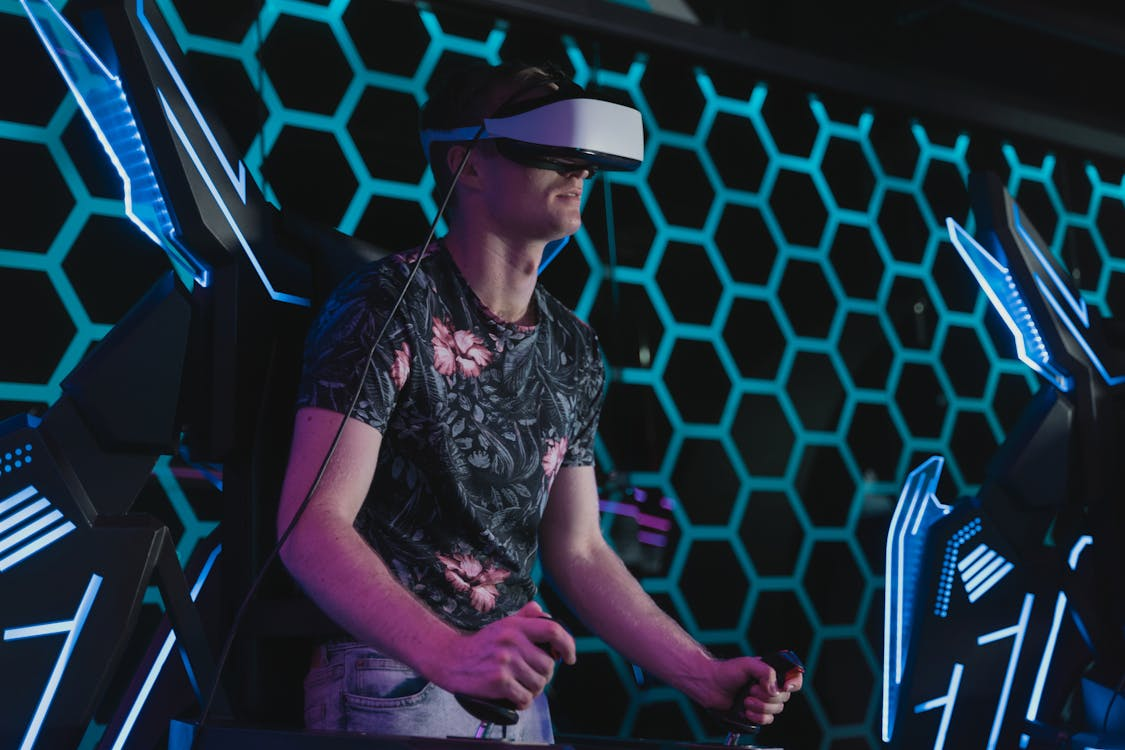Image source: https://www.pexels.com/photo/man-playing-virtual-reality-game-6498961/
Immersive leisure spaces are environments designed to fully engage people through interactive and sensory experiences. They combine technology, design, and storytelling to create memorable activities like virtual reality arcades, experiential museums, and virtual reality golf.
These places focus on transporting visitors into new worlds or unique scenarios that feel deeply engaging and personal.
But what does modern branding look like in these immersive leisure spaces? Let’s find out.
Using Bold and Eye-Catching Branded Signage
Bold signage plays a crucial role in immersive leisure spaces, grabbing attention and setting the tone. Things like oversized logos and high-quality displays ensure visitors instantly recognize brands upon entry.
For example, in places like virtual reality golf venues, large-scale branded signs can highlight entranceways or showcase key attractions while reinforcing brand identity.
Utilizing consistent brand elements, such as colors, matters too. (Take a look at the driving range at Atomic Golf in Las Vegas as an example.)
Also, LED boards or illuminated signage often double as decorative elements, blending style with functionality.
And strategically placed directional signs guide guests without losing visual appeal. For example, custom-branded arrows can feel both helpful and thematic within an immersive experience.
Bold branding enhances recall value while enriching the overall environment’s character.
Incorporating Logos into Themed Decor and Design
Logos in immersive leisure spaces should feel integral to the environment, not tacked on. They can become part of the decor, blending branding with the overall theme while reinforcing identity.
They can be embedded into wall patterns, floor designs, or props.
In a virtual reality arcade, for instance, a logo could be etched into futuristic furniture or displayed as holograms within game settings. These placements enhance recognition without disrupting immersion.
Interactive elements like branded photo-op backdrops provide visual consistency and social media opportunities.
Even small details—like logos subtly engraved on railings or incorporated into digital projection mapping—contribute to cohesion.
This approach integrates brands seamlessly into spaces while enhancing storytelling.
A strong presence woven into design keeps visitors connected to brand identity throughout their experience.
Customizing Staff Uniforms with Brand Identity
Staff uniforms in immersive leisure spaces are a subtle yet powerful branding tool. They reflect your brand’s personality and set the tone for guest interactions.
Uniforms should align with the theme of the space while incorporating recognizable brand elements like colors, logos, or patterns. For example, staff at a futuristic VR arena could wear sleek, branded jumpsuits that match the high-tech atmosphere.
Adding thoughtful touches—such as embroidered logos or name tags styled to fit the environment—reinforces consistency.
Branded uniforms not only help guests identify staff quickly but also make teams feel like an extension of the experience itself, solidifying a brand’s presence.
Creating Exclusive Branded Merchandise for Visitors
Exclusive merchandise is an effective way to extend a brand’s presence beyond the immersive space. By offering unique, high-quality items tied directly to the experience, companies can create lasting impressions while generating additional revenue.
For example, a virtual reality golf venue might sell branded hats or golf balls featuring its logo and theme-specific designs.
And limited-edition merchandise creates exclusivity, encouraging visitors to purchase as mementos or gifts.
Items like custom T-shirts, mugs, or even interactive collectibles resonate with guests when they reflect their time in the space.
Well-designed merch reinforces brand identity outside of the venue, while reminding visitors of their memorable experiences within it.
Adding Digital Branding Through Mobile Apps or AR Features
Digital tools like mobile apps and augmented reality (AR) offer dynamic ways to incorporate branding into immersive leisure spaces. Branded apps enhance the visitor experience by serving as guides, ticketing hubs, or platforms for interactive features.
For example, an app could include a map of the venue featuring custom graphics tied to brand identity.
Augmented reality adds another layer—visitors might scan branded markers to unlock hidden content or digital souvenirs that tie back to the theme.
Customizing interfaces with logos, colors, and typography ensures every touchpoint reinforces the brand.
These digital elements not only enrich engagement but also provide opportunities for guests to interact with a company’s branding long after their visit ends.
Designing Iconic Characters or Mascots Representing the Brand
Lastly, memorable characters or mascots bring brands to life in immersive leisure spaces. They create emotional connections and help guests associate fun, excitement, or adventure with a brand.
These mascots could be costumed performers interacting with visitors, digital avatars integrated into attractions, or stylized figures featured on signage and merchandise. For instance, a virtual reality park might introduce a futuristic guide character who “hosts” the experience.
Design should align with the brand’s identity—colors, personality traits, and storytelling all play key roles in making these icons unforgettable.
Iconic mascots leave lasting impressions while turning branding into an active part of the guest journey!

Leave a Reply